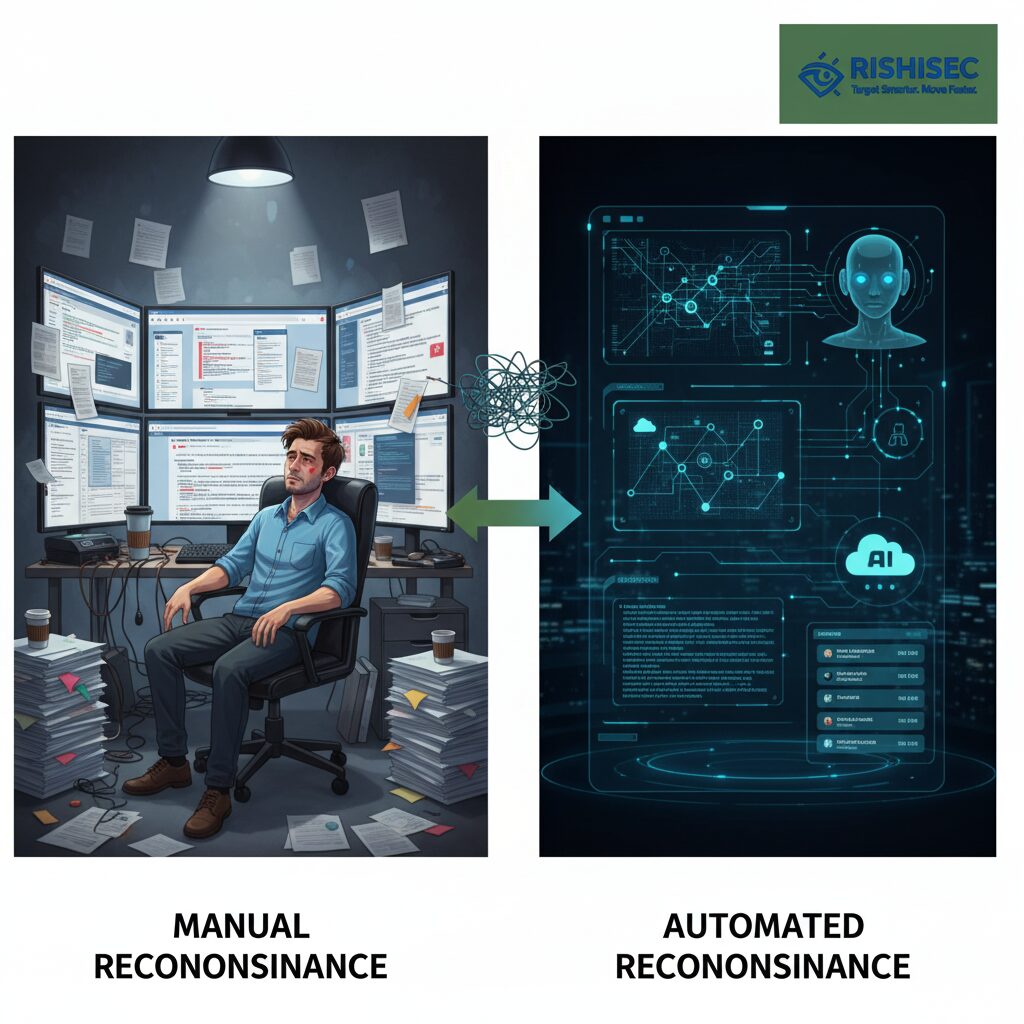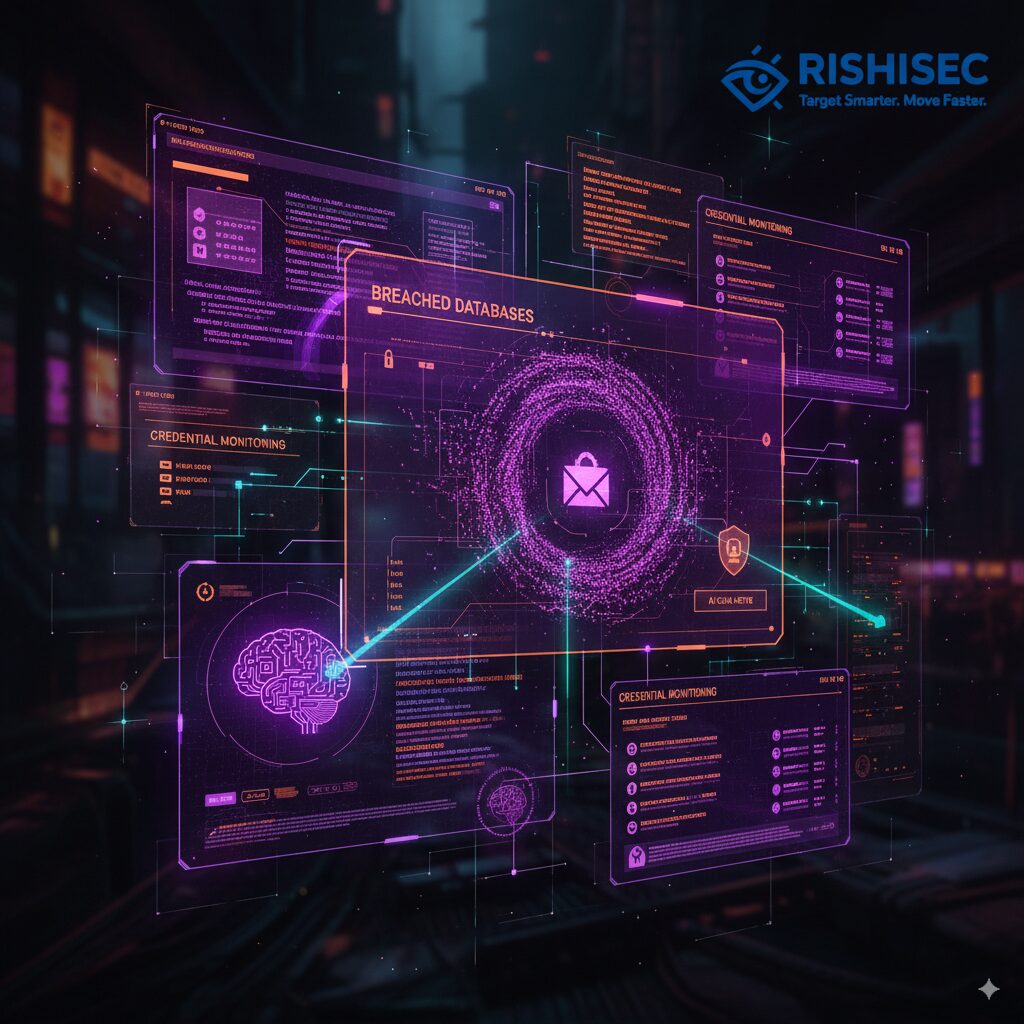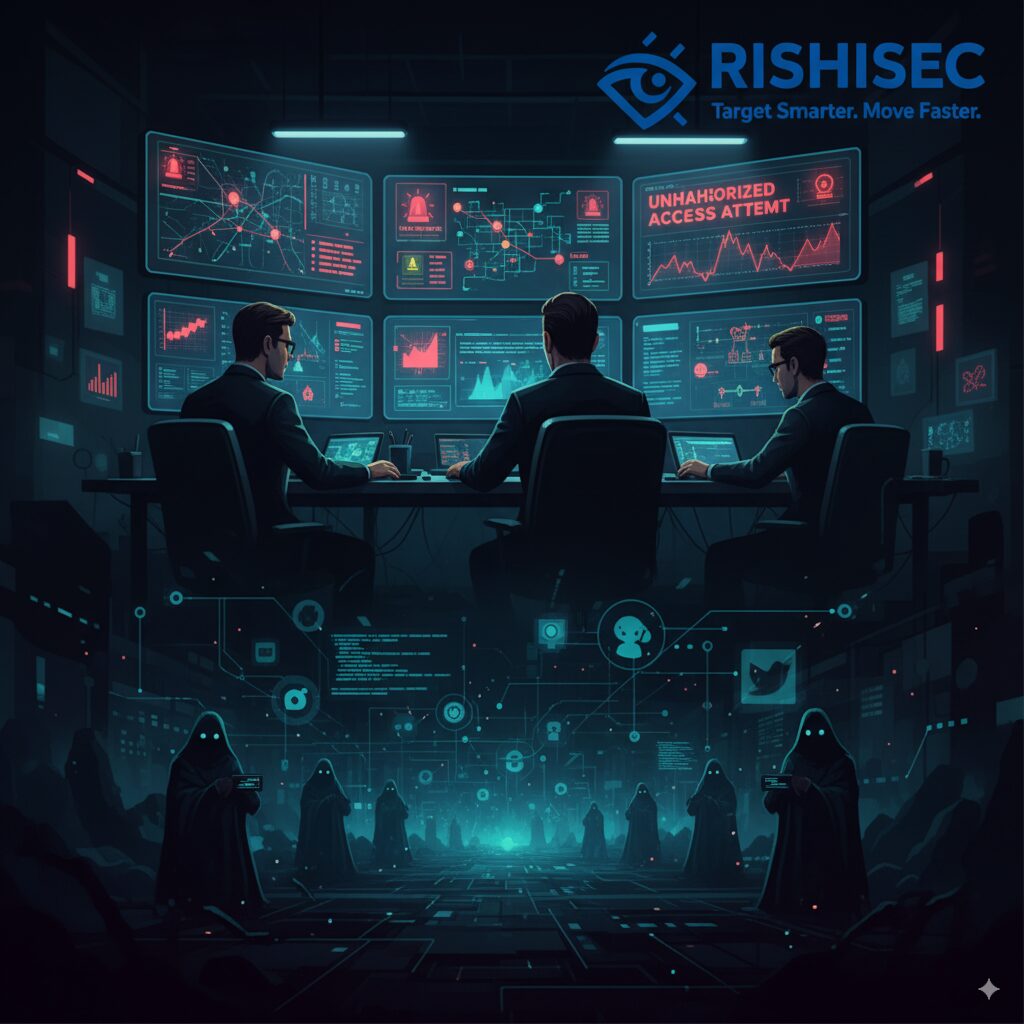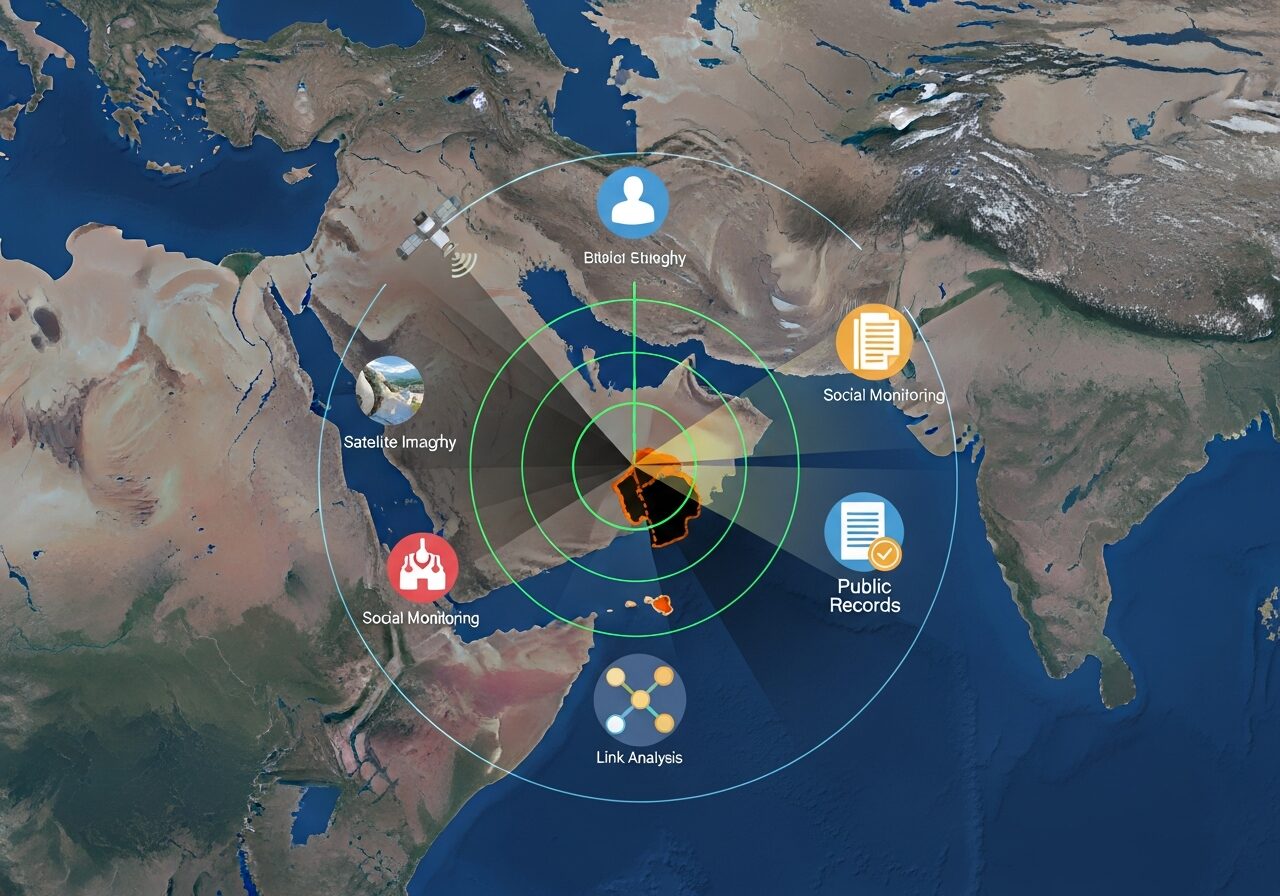A typical red team engagement begins with weeks of manual reconnaissance: searching domain records, mapping organizational structures, analyzing social media, and correlating scattered intelligence into actionable insights. This process consumes 60 to 80 percent of engagement time, leaving limited resources for actual penetration testing. Meanwhile, real adversaries deploy automated frameworks that complete the same reconnaissance in hours, not weeks. This disparity creates a critical problem: red teams operating with manual processes cannot adequately simulate modern threat actors who have already embraced automation.
The solution lies in automated OSINT reconnaissance that transforms intelligence gathering from a slow, analyst-intensive process into a rapid, scalable operation. By leveraging automation, red teams gain the speed and comprehensiveness necessary to simulate realistic attack scenarios while dedicating more resources to creative exploitation and thorough testing.
Why Reconnaissance Defines Red Team Success
Every successful penetration begins with understanding the target. Reconnaissance establishes the foundation for all subsequent attack phases, identifying vulnerabilities, mapping attack surfaces, and revealing human weaknesses that technical controls cannot address. Red teams that shortcut reconnaissance consistently miss critical vulnerabilities and fail to replicate real-world attack patterns.
The Traditional Reconnaissance Phase
Classic reconnaissance follows established methodologies: footprinting identifies the target’s digital presence, scanning enumerates systems and services, and enumeration extracts detailed configuration information. Analysts manually query WHOIS databases, DNS records, and search engines, documenting their findings in spreadsheets or text files.
This approach worked when organizational footprints were limited and attack surfaces were well-defined; however, modern cloud infrastructure, remote workforces, and sprawling digital ecosystems have exponentially increased reconnaissance scope. A single organization might maintain hundreds of domains, thousands of cloud assets, and employees spread across global locations, each component requiring individual investigation.
Why Manual Reconnaissance Wastes Critical Cycles
Manual OSINT suffers from fundamental inefficiencies. Analysts spend hours performing repetitive queries across multiple platforms, manually copying results, and attempting to correlate information stored in disconnected systems. Data overload overwhelms even experienced researchers, causing them to miss connections between seemingly unrelated intelligence.

Consistency issues plague manual reconnaissance. Different analysts employ varying methodologies, collect different types of data, and reach inconsistent conclusions about the same targets. This variability creates blind spots where critical intelligence falls through gaps in coverage. When teams rotate or analysts leave, institutional knowledge disappears, requiring expensive re-learning of target environments.
Time constraints force prioritization decisions that sacrifice thoroughness for speed. Analysts skip secondary sources, limit social media research, or truncate infrastructure mapping to meet engagement deadlines. These shortcuts create exactly the vulnerabilities that sophisticated attackers exploit through comprehensive reconnaissance that manual processes cannot match.
Attackers Automate, Red Teams Must Too
Cybercriminal groups and nation-state actors deploy sophisticated automation frameworks for reconnaissance. These tools continuously scan for exposed assets, monitor breach databases for new credentials, and track organizational changes that create exploitation opportunities. They operate 24/7 without fatigue, process millions of data points simultaneously, and identify attack vectors that manual analysis would never discover.
Red teams simulating these adversaries must employ equivalent capabilities. A penetration test that relies on manual reconnaissance fails to replicate the threats organizations actually face. When real attackers use automated OSINT reconnaissance to map entire networks in hours, defensive exercises must demonstrate similar capabilities to provide realistic security assessments.
Organizations investing in red team exercises expect testing that mirrors current threat landscapes. Manual methods cannot keep pace with automated adversaries, rendering traditional penetration tests increasingly irrelevant against modern attack methodologies.
The OSINT Toolbox for Red Team Reconnaissance
Effective automated reconnaissance requires understanding available tools and how they integrate into comprehensive intelligence workflows. The best red teams combine multiple specialized tools that each address specific reconnaissance requirements.
Domain and Infrastructure Discovery
Shodan and Censys serve as search engines for internet-connected devices, revealing exposed services, misconfigured systems, and unpatched vulnerabilities. These platforms index billions of systems, providing instant visibility into organizational attack surfaces without active scanning that might trigger defenses.
WHOIS databases disclose domain registration details, administrative contacts, and DNS server configurations. Passive DNS services track historical DNS records, revealing infrastructure changes, abandoned subdomains, and relationships between seemingly unrelated domains. Certificate transparency logs expose all SSL certificates issued for organizational domains, often revealing internal systems and development servers inadvertently exposed to the internet.
Cloud asset discovery tools enumerate AWS S3 buckets, Azure blob storage, and Google Cloud resources. Misconfigured cloud storage represents one of the most common data exposure vectors, and automated reconnaissance identifies these vulnerabilities without requiring authenticated access.
Credential and Dark Web Exposure
Billions of credentials circulate through data breaches, with new exposures occurring daily. Automated breach monitoring searches these databases for target organization email domains, then correlates discovered credentials with active accounts. Password pattern analysis predicts current credentials based on historical breach data, significantly improving authentication attack success rates.

Paste sites like Pastebin and GitHub inadvertently host sensitive information including credentials, API keys, and internal documentation. Automated monitoring scans these platforms continuously, alerting when organizational data appears in public contexts. This intelligence reveals both exposed credentials and insider threats, where employees share proprietary information inappropriately.
Dark web monitoring tracks when organizational credentials, documents, or intelligence appear in criminal marketplaces. This capability provides early warning of compromised accounts before attackers weaponize them, though it requires specialized access and ethical considerations around interacting with illegal platforms. Law enforcement OSINT tactics for dark web investigations inform red team approaches to this intelligence source.
Social and Organizational Mapping
LinkedIn provides organizational structure through connection analysis, job histories, and skill endorsements. Automated scrapers extract this information at scale, building comprehensive org charts that identify high-value targets, reporting relationships, and access levels. This intelligence informs social engineering pretexts and prioritizes exploitation targets.
Twitter, Facebook, and Instagram reveal personal information, behavioral patterns, and security weaknesses. Automated analysis identifies employees who overshare, expose family relationships, or broadcast travel plans. These personal details enable sophisticated social engineering that manual reconnaissance cannot match in depth or speed.
GitHub repositories expose technology stacks, coding standards, and occasionally hardcoded credentials. Automated code scanning identifies these exposures across thousands of repositories, revealing not just individual secrets but patterns indicating systemic security weaknesses in development practices.
Automating Reconnaissance from Hours to Minutes
The transformation from manual to automated reconnaissance requires understanding both technical implementation and operational workflows that maximize efficiency while maintaining accuracy.
Parallel Data Collection at Scale
Automation enables simultaneous querying of dozens of data sources. While one analyst might manually check ten platforms over several hours, automated systems query hundreds of sources concurrently, completing comprehensive reconnaissance in minutes. This parallelization fundamentally changes engagement economics, allowing smaller teams to tackle larger, more complex targets.
Distributed collection systems spread queries across multiple IP addresses and timing patterns to avoid rate limiting and detection. They rotate user agents, randomize query timing, and respect robots.txt restrictions while maintaining collection efficiency. This technical sophistication ensures comprehensive coverage without triggering defensive alerts that manual reconnaissance might miss.
Link Analysis for Rapid Pattern Recognition
Raw data becomes intelligence through correlation. Link analysis platforms automatically identify relationships between people, systems, and organizations that manual analysis would require days or weeks to uncover. Visual graph representations reveal attack paths, trust relationships, and infrastructure dependencies instantly recognizable to experienced analysts.
Machine learning algorithms detect patterns in seemingly random data. They identify which employees have access to critical systems based on job description analysis, predict credential reuse based on password pattern recognition, and suggest social engineering targets based on online behavior analysis. These insights accelerate the transition from reconnaissance to exploitation.
Case Scenario: Automated Supplier Mapping
Consider a red team engagement requiring supplier and vendor intelligence. Manual reconnaissance involves searching contract databases, analyzing invoices in breach data, and monitoring social media for vendor relationships. This process might take weeks and produce incomplete results.
| Reconnaissance Task | Manual Time | Automated Time | Improvement |
|---|---|---|---|
| Domain infrastructure mapping | 8-12 hours | 15-30 minutes | 95% faster |
| Employee social media profiling | 40-60 hours | 2-4 hours | 90% faster |
| Credential breach searches | 12-16 hours | 30-60 minutes | 92% faster |
| Vendor relationship mapping | 20-30 hours | 3-5 hours | 85% faster |
Automated reconnaissance completes supplier mapping by simultaneously searching LinkedIn for vendor employee connections, analyzing email domains in breach databases for vendor credentials, scanning certificate transparency logs for vendor infrastructure, and correlating job postings mentioning vendor technologies. This comprehensive approach identifies relationships manual analysis would miss while completing in hours rather than weeks.
The resulting intelligence enables targeted attacks against vendor relationships, demonstrating how supply chain compromises occur. Red teams can show clients exactly which vendors pose the greatest risk and how attackers would exploit these relationships, providing actionable intelligence for defensive improvements.
Challenges with Automation and How to Overcome Them
Automation introduces new challenges that red teams must address to maintain effectiveness and ethical standards. Understanding these limitations prevents over-reliance on automated systems while maximizing their benefits.
Filtering Signal from Noise
Automated collection generates massive data volumes, much of it irrelevant to engagement objectives. False positives overwhelm analysts, while critical intelligence hides among noise. Effective automation requires sophisticated filtering that removes junk data while preserving edge cases that might prove valuable.
Machine learning models improve filtering over time, learning which data sources provide reliable intelligence and which generate mostly noise. Human analysts must train these systems by marking false positives and validating true positives, creating feedback loops that continuously improve accuracy. This human-machine collaboration produces better results than either approach alone.
Context-aware filtering applies rules based on engagement scope and objectives. A red team focused on executive compromise filters for senior leader intelligence while discarding junior employee data. Geographic filters eliminate international entities outside engagement scope. These targeted approaches reduce data volume without sacrificing coverage of relevant intelligence.
Maintaining Operational Stealth
Aggressive automated reconnaissance risks detection by target security teams. Unusual query volumes, rapid-fire requests, and suspicious user agents trigger alerts in modern security operations centers. Red teams must balance speed against stealth, configuring automation to mimic legitimate user behavior.

Rate limiting and request throttling spread queries over time, avoiding the burst patterns that defensive systems flag. Residential proxy networks route traffic through legitimate IP addresses rather than datacenter ranges associated with automated scanning. These technical controls make automated reconnaissance indistinguishable from organic research activities.
However, absolute stealth remains impossible when collecting from platforms with anti-automation protections. Red teams must accept some detection risk or limit automation scope, accepting longer reconnaissance timelines to maintain operational security. This tradeoff requires engagement-specific decisions balancing speed, comprehensiveness, and detection risk.
Ethical Boundaries in Simulating Attackers
Automated reconnaissance can easily cross ethical lines when simulating adversary capabilities. Accessing dark web marketplaces, interacting with criminal forums, or purchasing stolen credentials raises legal and ethical questions even in authorized security testing contexts.
Red teams must establish clear rules of engagement defining acceptable intelligence sources and collection methods. They should avoid actually purchasing stolen data, instead demonstrating that organizational credentials are available without completing transactions. They must respect privacy laws governing personal information collection, even when such data is publicly accessible.
Documentation and transparency prove essential for maintaining ethical standards. Red teams should clearly record all reconnaissance activities, explain data sources, and obtain explicit authorization for any activity approaching legal or ethical boundaries. OSINT compliance frameworks provide guidance on maintaining ethical standards while conducting comprehensive intelligence operations.
How Kindi Accelerates Red Team Reconnaissance
Modern red teams require platforms that integrate multiple intelligence sources while providing analysis tools that transform raw data into actionable insights. Kindi addresses these requirements through AI-powered automation that dramatically reduces reconnaissance time while improving the quality of results.
One-click multi-source enrichment simultaneously queries dozens of OSINT platforms, breach databases, and social media sources. Rather than manually searching each platform individually, analysts input target parameters and receive comprehensive intelligence packages within minutes. This efficiency allows teams to conduct thorough reconnaissance even under tight engagement timelines.
Visual link analysis automatically identifies relationships between entities, revealing attack paths that manual analysis would require extensive time to uncover. The platform highlights high-value targets based on access levels, relationship patterns, and exposed vulnerabilities. These visual representations communicate complex intelligence to clients more effectively than traditional report formats.
Collaboration features enable multiple analysts to work simultaneously on complex engagements. Team members share findings in real-time, building collective intelligence that prevents duplication of effort. Version control tracks how intelligence evolves throughout engagements, providing audit trails that demonstrate due diligence.
Export capabilities transform reconnaissance data into professional reports complete with visual evidence chains, vulnerability summaries, and remediation recommendations. Clients receive clear documentation showing exactly what intelligence attackers could gather, how this information enables exploitation, and which defensive measures would reduce exposure.
By reducing reconnaissance time by up to 80 percent, Kindi allows red teams to dedicate more resources to creative exploitation and thorough testing. Engagements become more comprehensive without increasing costs, making professional security testing accessible to organizations that previously could not afford extensive red team services. AI-powered automation transforms red team economics while improving result quality.
Conclusion
The reconnaissance phase determines red team engagement success. Comprehensive intelligence gathering reveals vulnerabilities, identifies attack paths, and enables realistic threat simulation. However, manual reconnaissance cannot match the speed and thoroughness that modern adversaries achieve through automation.
Automated OSINT reconnaissance transforms intelligence gathering from a time-consuming bottleneck into a rapid, scalable process. By leveraging specialized tools, parallel data collection, and AI-powered analysis, red teams complete weeks of manual work in hours while achieving better coverage and deeper insights.
The challenges of automation, including noise filtering, maintaining stealth, and respecting ethical boundaries, require careful consideration and proper tooling. Organizations that successfully implement automated reconnaissance gain significant competitive advantages, conducting more comprehensive security assessments with smaller teams and tighter budgets.
As threat actors continue embracing automation, red teams must match these capabilities to provide realistic security testing. The organizations that adapt to automated reconnaissance methodologies will better protect their clients by demonstrating exactly how modern attackers operate and what defenses actually work against sophisticated, automated threats.
See how Kindi reduces reconnaissance time by 80 percent and transforms your red team’s intelligence gathering capabilities. Start your free trial today.
Want to strengthen your OSINT skills and master automated reconnaissance techniques? Check out our OSINT courses for practical, hands-on training that prepares security professionals for modern intelligence operations.
FAQ
What is automated OSINT reconnaissance?
Automated OSINT reconnaissance uses software tools and AI-powered platforms to collect and analyze publicly available information about target organizations. Instead of manually querying dozens of data sources, automated systems simultaneously gather intelligence from social media, breach databases, domain records, and other sources, then correlate this data to identify vulnerabilities and attack paths. This approach reduces reconnaissance time from weeks to hours while improving coverage and consistency.
How does automated reconnaissance benefit red teams?
Automation allows red teams to complete comprehensive reconnaissance in a fraction of the time required for manual processes. Teams can tackle larger, more complex engagements with smaller analyst groups. Automated systems provide consistent methodology across different engagements and analysts, eliminating the variability that creates blind spots in manual reconnaissance. The time saved on data collection allows teams to focus on creative exploitation and thorough testing, improving overall engagement quality.
What tools do red teams use for automated reconnaissance?
Red teams employ a variety of specialized tools including Shodan and Censys for infrastructure discovery, breach database monitors for credential exposure, LinkedIn scrapers for organizational mapping, and GitHub scanners for code analysis. Platforms like Kindi integrate multiple intelligence sources with AI-powered analysis, providing comprehensive reconnaissance through single interfaces. The specific toolset varies based on engagement requirements, target characteristics, and team expertise, but most modern red teams combine several specialized tools into automated workflows.
How do red teams maintain stealth during automated reconnaissance?
Stealth requires careful configuration of automated tools to mimic legitimate user behavior. Red teams implement rate limiting to avoid burst query patterns that trigger security alerts, use residential proxy networks instead of datacenter IP addresses, and randomize user agents and request timing. They balance speed against detection risk by spreading reconnaissance over longer timeframes when necessary. Some platforms implement anti-automation protections that make complete stealth impossible, requiring engagement-specific decisions about acceptable detection risk versus reconnaissance comprehensiveness.
What are the ethical considerations in automated OSINT reconnaissance?
Automated reconnaissance must respect legal and ethical boundaries even when simulating adversary capabilities. Red teams should avoid purchasing stolen data, respect privacy laws governing personal information collection, and obtain explicit authorization for activities approaching legal boundaries. Clear rules of engagement define acceptable intelligence sources and collection methods. Comprehensive documentation proves due diligence and maintains transparency with clients. OSINT compliance frameworks provide guidance on conducting thorough intelligence operations while respecting legal and ethical constraints.



